Wall Pop vs Putty – Explore the key differences between POP (Plaster of Paris) and wall PuTTY. Learn about their composition, uses, advantages, and which one is best for your construction or renovation project.
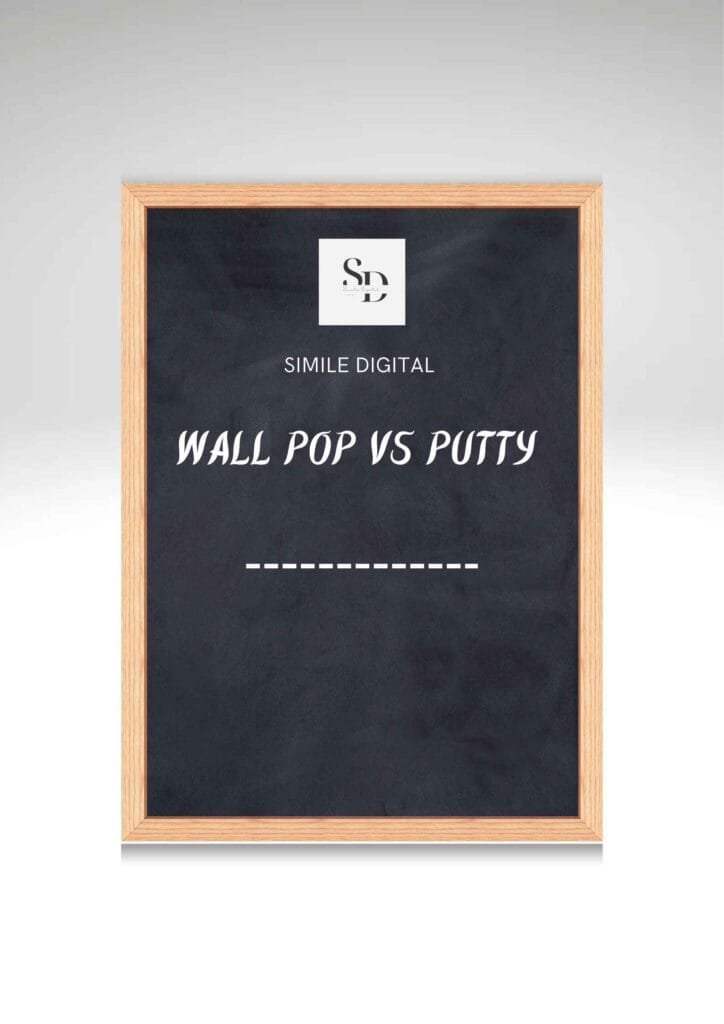
Table of Contents
Introduction
When it comes to wall finishing in construction or home interiors, two names that often come up are POP and PuTTY. Though they might seem similar to a casual observer, POP (Plaster of Paris) and wall PuTTY serve very different purposes and offer unique benefits. Choosing the right material depends on where and how you plan to use it—be it for creating smooth surfaces, decorative designs, or providing strength to painted walls.
Plaster of Paris has been a trusted material for decades, known for its ability to create elegant moldings, intricate ceiling designs, and false ceilings. On the other hand, wall PuTTY has gained popularity in recent years as a reliable base for painting, ensuring that your wall not only looks smooth but also retains paint for a longer time without peeling or cracking.
This blog will take a deep dive into the differences between POP and PuTTY, covering their composition, characteristics, application techniques, and the advantages and limitations of each. Whether you’re a homeowner planning a renovation, a contractor working on a new project, or a curious learner, this guide will help you make informed choices for better wall finishes.
Stay tuned as we compare POP and PuTTY based on Indian construction standards and real-world usability.
Key Characteristics (Line-by-Line Format)
- Base Material: POP is made from Gypsum; PuTTY is made from White Cement and polymers.
- Setting Time: POP sets quickly in 10–15 minutes; PuTTY sets slower, giving more working time.
- Surface Finish: POP gives a super smooth decorative finish; PuTTY offers a smooth, paintable surface.
- Strength: POP has lower structural strength; PuTTY provides better tensile and adhesion strength.
- Moisture Resistance: POP is not moisture resistant; PuTTY has better moisture resistance, suitable for slightly damp areas.
- Best Used For: POP is ideal for decorative designs and ceilings; PuTTY is best for wall preparation before painting.
- Application Area: POP is used only for interiors; PuTTY is suitable for both interior and exterior walls.
- Flexibility: POP is more brittle; PuTTY is more flexible and durable.
- Paint Compatibility: POP is not a direct base for paint; PuTTY is a perfect base for any kind of wall paint.
- Crack Resistance: POP may crack if not applied correctly; PuTTY resists hairline cracks and flaking.
- Working Time: POP needs quick application; PuTTY offers comfortable working time.
Uses of POP (Plaster of Paris) and Wall Putty
Uses of POP (Plaster of Paris)
- Plaster of Paris (POP) is widely used in both the construction and creative design industries due to its quick-setting nature and smooth finish. Some common uses include:
- False Ceilings: POP is a go-to material for making stylish false ceilings in homes, offices, and commercial spaces.
- Wall Cornices and Moldings: Ideal for decorative trims, borders, and design elements around ceilings and walls.
- Repair Work: Used for patching cracks and holes in plastered walls before repainting or renovation.
- Sculptures and Art: Preferred by artists for creating sculptures, idols, and other artistic elements.
- Medical Applications: Extensively used in orthopedics for making plaster casts to support broken bones.
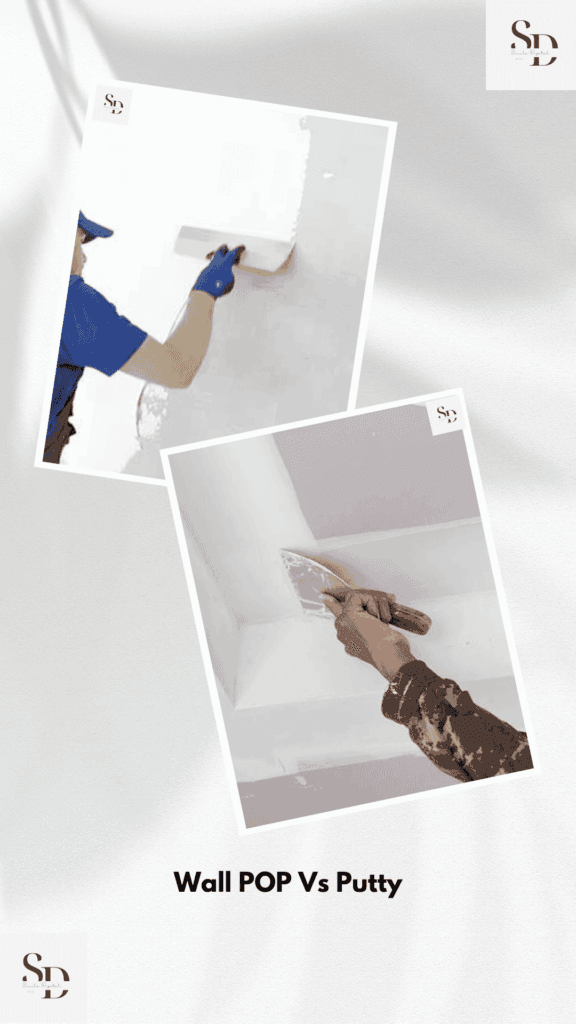
Uses of Wall PuTTY
- Wall PuTTY is primarily used as a preparatory base on walls before painting. Its smooth texture and adhesive quality make it ideal for:
- Smoothing Wall Surfaces: Applied on interior and exterior walls to remove undulations, cracks, or imperfections.
- Base for Paint: Ensures better bonding and a longer life for the paint coat.
- Moisture Resistance: Particularly helpful in slightly damp areas where minor water resistance is required.
- Prevents Flaking: Stops the paint from peeling off or getting powdery over time.
Advantages and Disadvantages
Advantages of Wall PuTTY
- Smooth Finish: Offers a fine and even surface, making paint application easy and appealing.
- Moisture Resistance: Protects walls from dampness and reduces paint peeling.
- Increased Paint Lifespan: Enhances the life and quality of wall paint.
- Crack Resistance: Prevents hairline cracks from appearing on painted surfaces.
- Exterior Use: Can be used both inside and outside, making it versatile.
Disadvantages of Wall PuTTY
- Needs Skillful Application: Requires a trained hand for a perfect smooth finish.
- Time-Consuming: Drying and layering can take time, delaying the painting process.
- Limited Decorative Use: Cannot be used for ornamental or sculptural work.
- Not Load Bearing: Only a surface treatment; adds no structural strength.
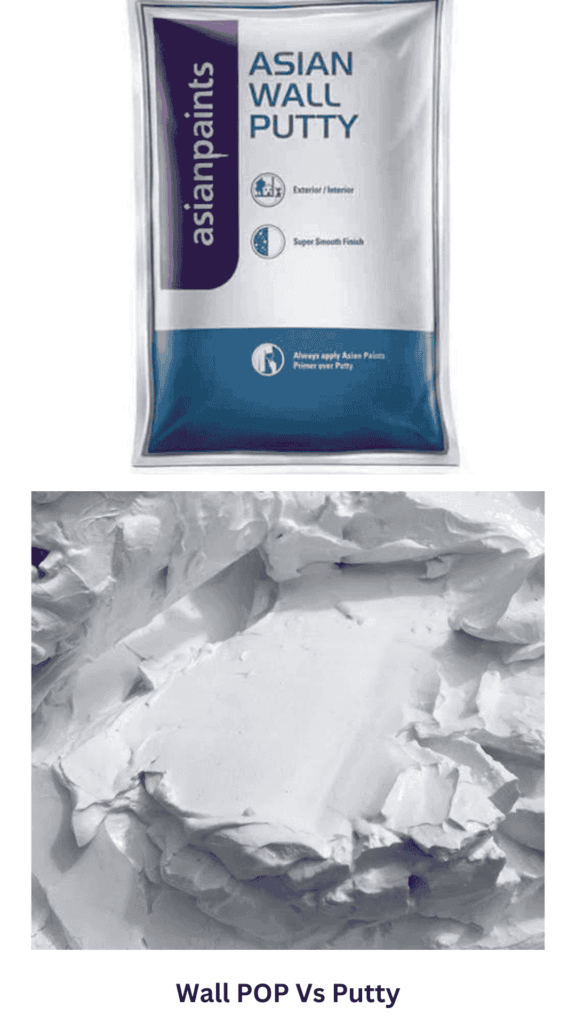
Advantages of POP (Plaster of Paris)
- Excellent for Detailing: Ideal for crafting intricate decorative patterns, moldings, and false ceilings.
- Quick Setting: Sets quickly upon mixing with water, saving time in finishing work.
- Lightweight: Reduces the load on ceilings and walls.
- Cost-Effective: Cheaper than some alternatives for decorative work.
- Good Insulation: Offers sound and thermal insulation to some extent.
Disadvantages of POP (Plaster of Paris)
- Not Water-Resistant: Easily damaged in humid or wet conditions.
- Brittle Nature: Can develop cracks if not applied properly or if exposed to shocks.
- Short Working Time: Needs to be applied quickly after mixing due to fast setting.
- Surface Pre-Treatment Required: Needs proper surface preparation before application.
Composition of POP and Wall PuTTY
POP (Plaster of Paris):
- Made by heating gypsum (calcium sulfate dihydrate) at around 150°C.
- The resulting powder, calcium sulfate hemihydrate, reacts with water to form a hard paste.
- The main component is Calcium Sulphate Hemihydrate (CaSO₄·½H₂O).
- Use: When mixed with water, POP forms a paste that sets into a solid structure through an exothermic reaction.
Wall PuTTY:
- Typically made of White Cement (mostly Calcium Hydroxide and Calcium Silicates), with added polymers, minerals, and additives to enhance workability and adhesion.
- It may also contain additives that improve adhesion, workability, and water resistance.
- Use: Acts as a base coat for painting, improving the finish and life of the paint layer.
How to Apply
How to Apply Wall PuTTY – Step-by-Step Process
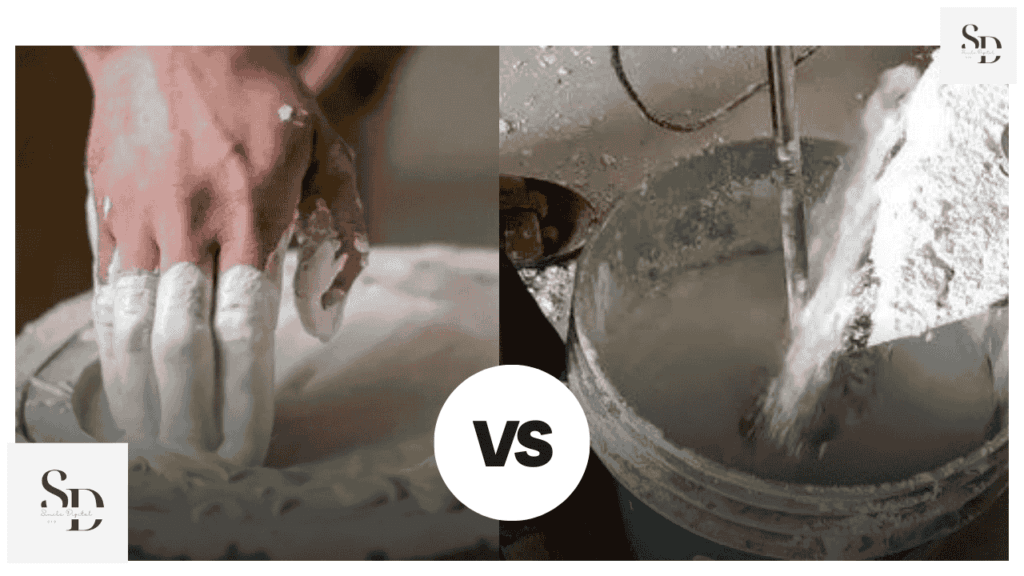
Materials & Tools Required:
- Wall PuTTY (white cement-based)
- Clean water
- Putty blade or spatula
- Sandpaper (100–220 grit)
- Trowel or putty trowel
- Primer (for pre/post application)
- Mixing container
Step-by-Step Application:
1. Surface Preparation:
- Ensure the wall surface is clean, dry, and free from dust, grease, or flaky particles.
- Repair all cracks, holes, and damp patches.
- Apply a coat of primer (optional, depending on surface type).
2. Mixing:
- Mix wall putty with clean water (approx. 40–45% by weight).
- Stir thoroughly to form a smooth, lump-free paste.
- Let it stand for 10–15 minutes before applying.
3. First Coat:
- Apply the first coat evenly with a putty knife or trowel.
- Maintain 1–1.5 mm thickness.
- Let it dry completely for 6–8 hours.
4. Sanding:
- Lightly sand the surface with fine sandpaper after the first coat dries.
5. Second Coat:
- Apply a second coat for smoother finish.
- Let it dry for 10–12 hours (or more in humid conditions).
6. Final Sanding:
- Smoothen the surface with 220-grit sandpaper.
7. Painting:
- Apply a primer coat after final sanding.
- You can begin painting after 24 hours of applying putty (if surface is dry).
How to Apply Plaster of Paris (POP) – Step-by-Step Process
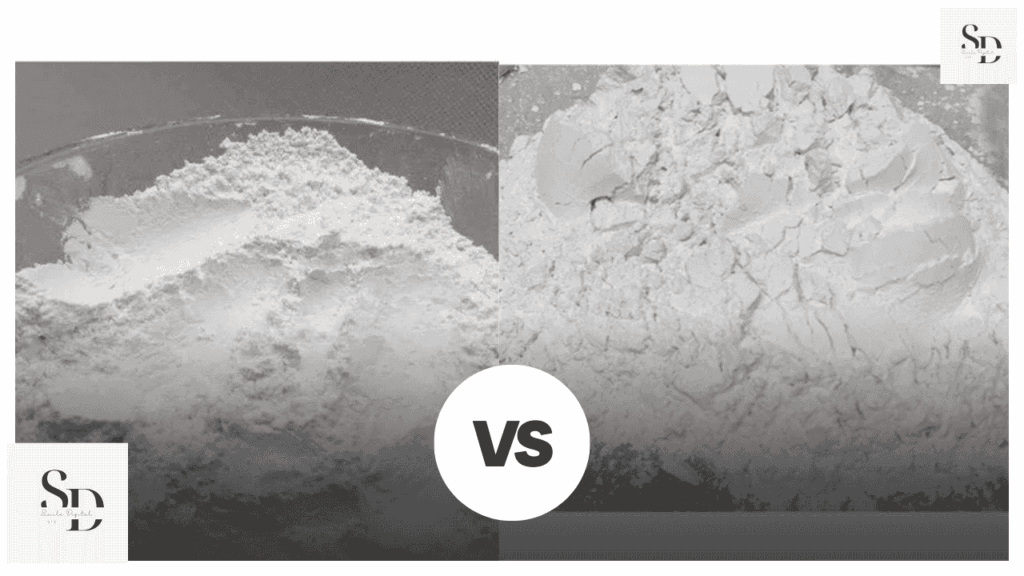
Materials & Tools Required:
- POP powder
- Clean water
- Mixing bucket or tray
- Trowel or metal float
- Sandpaper (if needed)
- Fiber mesh (optional for joints/crack resistance)
Step-by-Step Application:
1. Surface Preparation:
- Clean the wall/ceiling of all dust, oil, or loose particles.
- Dampen the surface slightly (don’t over-wet).
2. Mixing:
- Mix POP powder with water in a 2:1 ratio (POP:water).
- Mix quickly and thoroughly to avoid setting in the container.
- Use within 10–15 minutes of mixing, as POP sets fast.
3. Application:
- Apply POP paste evenly with a trowel or spatula.
- Use for leveling, surface correction, or decorative work (false ceiling, cornices).
- Recommended thickness: 6–12 mm, not exceeding 15 mm.
4. Finishing:
- Smoothen the surface while the POP is still soft.
- Use metal float for finer finish.
5. Drying Time:
- Let the surface dry for at least 24–48 hours.
- Don’t paint until it’s completely dry (no moisture).
6. Sanding (Optional):
- Lightly sand with fine sandpaper to smooth imperfections.
7. Painting:
- Apply a primer coat, and wait 12–24 hours before painting.
When Should You Paint After Applying PuTTY or POP?
- Wall PuTTY: Paint after 24 hours of the final coat, once fully dry and smoothened.
- POP: Paint after 48 hours, ensuring the surface has no trapped moisture.
Which is Better – POP or Wall PuTTY for Your House?
For Interior Walls & Ceilings:
- Use POP when you want:
- Decorative false ceilings
- Cornices, moldings, or artistic designs
- A very smooth surface finish before painting
Use PuTTY when you want:
- A solid, crack-resistant, paint-ready surface
- Better adhesion and long-term durability under paint
- Moisture resistance for bathrooms or kitchens
Recommendation: Use POP for ceiling work and decorative purposes, and Wall PuTTY over plastered walls for final paint base.
For Exterior Walls:
- Use Wall PuTTY only.
- POP is not water-resistant and will degrade over time in outdoor conditions.
- Choose exterior-grade cement-based putty like Birla White or JK Exterior Wall Putty.
Recommendation: Never use POP outside; always prefer exterior-grade putty for weather protection and longevity.
Which to Use First?
During house construction:
- First, plaster the surface with cement mortar.
- Then, apply POP if decorative work is needed.
- Finally, apply Wall PuTTY as a finishing coat before painting.
IS Codes for POP and Wall PuTTY in India
While there is no specific IS code solely for “Wall PuTTY,” it is generally covered under broader categories related to surface finishes. Here are the relevant standards:
For POP (Plaster of Paris):
- IS 2547 (Part I & II): Covers gypsum building plaster including Plaster of Paris – specifications, usage, and physical properties.
- IS 8272: Code of practice for gypsum plaster boards.
- IS 2095: Specifications for gypsum plaster boards.
- IS 3462: Specifications for gypsum plaster (including POP for decorative purposes).
For Wall PuTTY:
- There is no direct IS code for all-purpose wall putty. However, it is treated under:
- IS 1661: Code of practice for application of cement plaster to masonry.
- IS 269: Specification for ordinary Portland cement (base for white cement putties).
- IS 712: Specification for building limes (for lime-based putties).
Books
- Building Construction by B.C. Punmia
- Construction Technology by R. Chudley
- Interior Construction & Detailing for Designers and Architects by David Kent Ballast
Conclusion
When it comes to enhancing the beauty and durability of your home’s walls and ceilings, both Plaster of Paris (POP) and Wall PuTTY serve unique purposes. POP shines in artistic and decorative applications—especially for false ceilings, cornices, and moldings—thanks to its smooth finish and design flexibility. However, it is limited to interior spaces due to its poor moisture resistance.
On the other hand, Wall PuTTY proves to be an all-rounder when it comes to providing a strong, smooth, and paint-ready surface. Its cement-based formulation makes it ideal for both interior and exterior walls, offering better adhesion, water resistance, and durability.
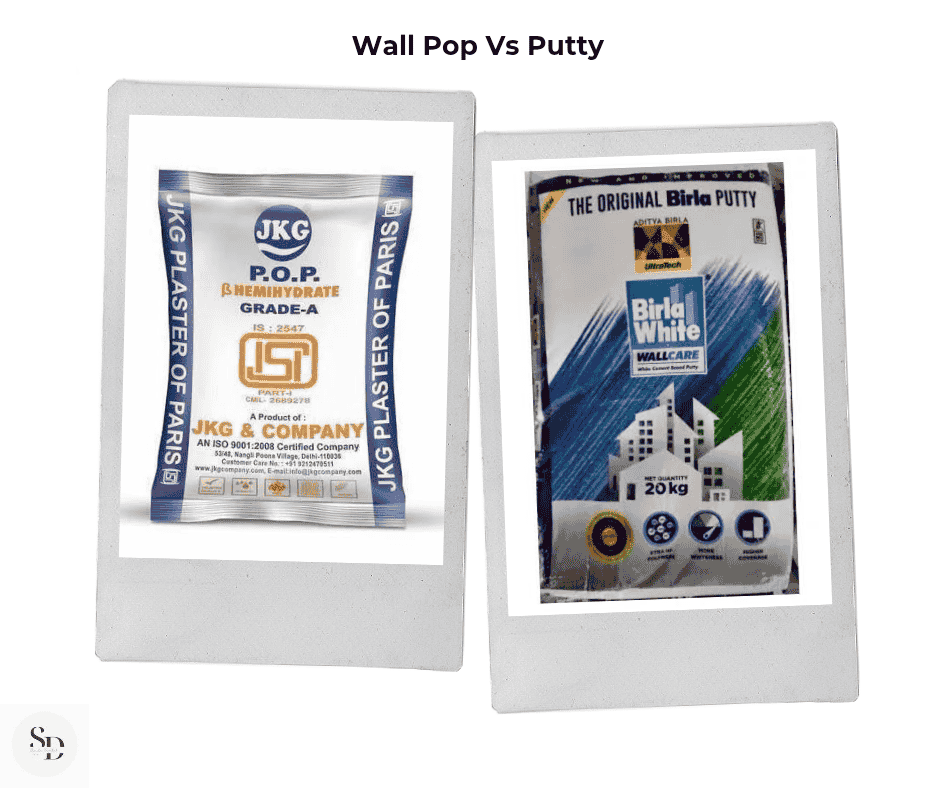
For a flawless finish, professionals typically prefer a combination of both: POP for ceiling designs and PuTTY as the final coating on walls before painting. With the right brands, proper surface preparation, and application techniques, you can ensure a long-lasting and stunning finish for your home.
Thank You Note
Thank you for taking the time to read this comprehensive guide on POP vs. Wall PuTTY. We hope this blog helped you understand the differences, applications, and best practices for using these essential building materials. Whether you’re a homeowner, a contractor, or an interior designer, making informed choices can truly transform your space.
If you found this guide useful, feel free to share it with others in the construction industry. Stay tuned for more informative content on construction materials and testing methods.
Happy learning and building!
Frequently Asked Questions (FAQs)
What IS codes are relevant for POP and PuTTY?
What are the best brands for POP and PuTTY in India?
Wall PuTTY: Birla White, JK Wall Putty, Asian Paints TruCare, Nerolac, Dr. Fixit.
What’s the application sequence during home construction – POP or PuTTY first?
Can we use POP on exterior walls?
Which material is stronger – POP or Wall PuTTY?
What is the major difference between POP and Wall PuTTY?
Note for Readers
If you’d like to read this blog in your regional language or any other international language, simply click on the Google Translator option located in the bar at the top of the page. This feature allows you to select your preferred language and enjoy the content in a way that’s comfortable for you. We hope this makes your reading experience more enjoyable and accessible!
Disclaimer
This article is intended for informational purposes only. The consumption values, brand suggestions, and application methods mentioned here are based on general industry standards and may vary depending on project size, surface condition, local climate, and application technique. Always consult with a certified civil engineer, contractor, or product specialist for personalized advice. We do not endorse any particular brand and recommend using materials that suit your specific requirements and comply with Indian building norms.
For more exciting topics, explore our other articles here
- Concrete Test: Field vs Lab
- Soil Test: Field vs Lab
- Steel Test: Field vs Lab
- Concrete: DT vs NDT
- Brick Test: Field vs Lab
- Coarse Aggregate Test: Field vs. Lab
- Sand Test : Field vs Lab
- Cement Test : Field Vs Lab
- PCC vs RCC
- One-Way Slab vs. Two-Way Slab
- Brick Masonry vs Stone Masonry
- Difference Between OPC and PPC Cement
One Comment